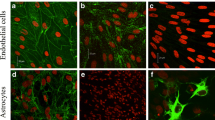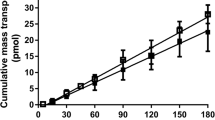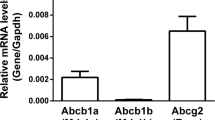Abstract
Purpose. Previous studies demonstrated that inhibition of P glycoprotein (P-gp) by Pluronic P85 (P85) block copolymer increases apical (AP) to basolateral (BL) transport of rhodamine 123 (R123) in the polarized monolayers of bovine brain microvessel endothelial cells (BBMEC) and Caco-2 cells. The present work examines the effects of P85 on the transport of fluorescein (Flu), doxorubicin (Dox), etoposide (Et), taxol (Tax), 3′-azido-3′-deoxythymidine (AZT), valproic acid (VPA) and loperamide (Lo) using BBMEC and Caco-2 monolayers as in vitro models of the blood brain barrier and intestinal epithelium respectively.
Methods. Drug permeability studies were performed on the confluent BBMEC and Caco-2 cell monolayers mounted in Side-Bi-Side diffusion cells.
Results. Exposure of the cells to P85 significantly enhanced AP to BL permeability coefficients of Flu, Tax, Dox and AZT in both cell models. Further, P85 enhanced AP to BL transport of Et, VPA and Lo in Caco-2 monolayers. No changes in the permeability coefficients of the paracellular marker mannitol were observed in the presence of the copolymer.
Conclusions. P85 increases AP to BL permeability in BBMEC and Caco-2 monolayers with respect to a broad panel of structurally diverse compounds, that were previously shown to be affected by P-gp and/ or multidrug resistance associated protein (MRP) efflux systems. Broad specificity of the block copolymer effects with respect to drugs and efflux systems appears to be a valuable property in view of developing pharmaceutical formulations to increase drug accumulation in selected organs and overcome both acquired and intrinsic drug resistance that limits the effectiveness of many chemotherapeutic agents.
Similar content being viewed by others
REFERENCES
V. Ling. Multidrug resistance: molecular mechanisms and clinical relevance. Cancer Chemother. Pharmacol. 40 Suppl:S3-8 (1997).
A. Krishan, C. M. Fitz, and I. Andritsch. Drug retention, efflux, and resistance in tumor cells. Cytometry 29:279-285 (1997).
H. W. Van Veen and W. N. Konings. Multidrug transport from bacteria to man: similarities in structure and function. Semin. Cancer Biol. 8:183-191 (1997).
B. L. Lum and M. P. Gosland. MDR expression in normal tissues. Drug Resist. Clin. Oncol. Hematol. 9:319-336 (1995).
C. Cordon-Cardo, J. P. O'Brien, D. Casals, L. Rittman-Grauer, J. L. Biedler, M. R. Melamed, and J. R. Bertino. Multidrug resistance gene (P-glycoprotein) is expressed by endothelial cells at blood-brain barrier sites. Proc. Natl. Acad. Sci. USA. 86:695-698 (1989).
W. H. M. Peters, C. E. W. Boon, H. M. J. Roelofs, T. Wobbes, F. M. Nagengast, and P. G. Kremers. Expression of drug-metabolizing enzymes and P-170 glycoprotein in colorectal carcinoma and normal mucosa. Gastroenterol. 103:448-455 (1992).
M. Fontaine, W. F. Elmquist, and D. W. Miller. Use of rhodamine 123 to examine the functional activity of P-glycoprotein in primary cultured brain microvessel endothelial cell monolayers. Life Sci. 59:1521-1531 (1996).
Y. H. Huai, D. T. Secrest, K. S. Mark, D. Carney, C. Brandquist, W. F. Elmquist, and D. W. Miller. Expression of multidrug resistance-associated protein (MRP) in brain microvessel endothelial cells. Biochem. Biophys. Res. Comm. 243:816-820 (1998).
K. I. Hosoya, K. J. Kim, and V. H. Lee. Age-dependent expression of P-glycoprotein gp170 in Caco-2 cell monolayers. Pharm. Res. 13:885-890 (1996).
V. D. Makhey, A. Guo, D. A. Norris, P. Hu, J. Yan, and P. J. Sinko. Characterization of the regional intestinal kinetics of drug efflux in rat and human intestine and in Caco-2 cells. Pharm. Res. 15:1160-1167 (1998).
V. Yu. Alakhov, E. Y. Moskaleva, E. V. Batrakova, and A. V. Kabanov. Hypersensitization of multidrug resistant human ovarian carcinoma cells by Pluronic P85 block copolymer. Bioconjugate Chem. 7:209-216 (1996).
A. Venne, S. Li, R. Mandeville, A. Kabanov, and V. Alakhov. Hypersensitizing effect of pluronic L61 on cytotoxic activity, transport and subcellular distribution of doxorubicin in multiple drug-resistant cells. Cancer Res. 56:3626-3629 (1996).
D. W. Miller, E. V. Batrakova, and A. V. Kabanov. Inhibition of multidrug resistance-associated protein (MRP) functional activity with Pluronic block copolymers. Pharm Res. 16:396-401 (1999).
D. W. Miller, E. V. Batrakova, T. O. Waltner, V. Yu. Alakhov, and A. V. Kabanov. Interactions of Pluronic block copolymers with brain microvessel endothelial cells: evidence of two potential pathways for drug absorption. Bioconjug. Chem. 8:649-657 (1997).
E. V. Batrakova, H-Y. Han, V. Yu. Alakhov, D. W. Miller, and A. V. Kabanov. Effect of Pluronic block copolymers on drug absorption in Caco-2 cell monolayers. Pharm. Res. 15:852-857 (1998).
E. V. Batrakova, H-Y. Han, D. W. Miller, and A. V. Kabanov. Effects of Pluronic P85 unimers and micelles on drug permeability in polarized BBMEC and Caco-2 cells. Pharm. Res. 15:1525-1532 (1998).
D. W. Miller, K. L. Audus, and R. T. Borchardt. Application of cultured bovine brain endothelial cells of the brain microvasiculature in the study of the blood-brain barrier. J. Tiss. Cult. Meth. 14:217-224 (1992).
J. Fogh, J. M. Fogh, and T. J. Orfeo. One hundred and twenty seven cultured human cell lines producing tumors in nude mice. J. Natl. Cancer Inst. 59:221-226 (1977).
G. M. Pauletti, S. Gangwar, F. W. Okumu, T. J. Siahaan, V. J. Stella, and R. H. Borchardt. Esterase-sensitive cyclic prodrugs of peptides: evaluation of an acyloxyalkoxy promoiety in a model hexapeptide. Pharm. Res. 13:1615-1623 (1996).
J. Karlsson and P. Arturson. A new diffusion chamber system for the determination of drug permeability coefficients across the human intestinal epithelium that are independent of the unstirred water layer. Biochim. Biophys. Acta. 1111:204-210 (1992).
W. Berger, L. Elbling, E. Hauptmann, and M. Micksche. Expression of the multidrug resistance-associated protein (MRP) and chemoresistance of human non-small-cell lung cancer cells. Int. J. Cancer. 73:84-93 (1997).
M. Essodaigui, H. J. Broxterman, and A. Garnier-Suillerot. Kinetic analysis of calcein and calcein-acetoxymethylester efflux mediated by the multidrug resistance protein and P-glycoprotein. Biochemistry 37:2243-2250 (1998).
J. Van Ark Otte, G. Samelis, G. Rubio, J. B. Lopez-Saez, H. M. Pinedo, and G. Giaccone. Effects of tubulin-inhibiting agents in human lung and breast cancer cell lines with different multidrug resistance phenotypes. Oncol. Rep. 5:249-255 (1998).
K. Takasawa, T. Terasaki, H. Suzuki, and Y. Sugiyama. In vivo evidence for carrier-mediated efflux transport of 3′-azido-3′-deoxythymidine and 2′,3′-dideoxyinosine across the blood-brain barrier via a probenecid-sensitive transport system. J. Pharmacol. Exp. Ther. 281:369-375 (1997).
D. Wu, J. G. Clement, and W. M. Pardridge. Low blood-brain barrier permeability to azidothymidine (AZT), 3TC, and thymidine in the rat. Brain Res. 791:313-316 (1998).
Y. Wang, Y. Wei, and R. J. Sawchuk. Zidovudine transport within the rabbit brain during intracerebroventricular administration and the effect of probenecid. J. Pharm. Sci. 86:1484-1490 (1997).
K. D. Adkinson, K. M. Powers, A. A. Artru, and D. D. Shen. Effect of para-aminohippurate on the efflux of valproic acid from the central nervous system of the rabbit. Epilepsy Res. 23:95-104 (1996).
A. H. Schinkel, E. Wagenaar, C. A. Mol, and L. van-Deemter. P-glycoprotein in the blood-brain barrier of mice influences the brain penetration and pharmacological activity of many drugs. J. Clin. Invest. 97:2517-2524 (1996).
M. M. Nerurkar, N. F. H. Ho, P. S. Burton, T. J. Vidmar, and R. T. Borchardt. Mechanistic roles of neutral surfactants on concurrent polarized and passive membrane transport of a model peptide in Caco-2 cells. J. Pharm. Sci. 7:813-821 (1997).
E. V. Batrakova, T. Yu. Dorodnych, E. Yu. Klinskii, E. N. Kliushnenkova, O. B. Shemchukova, S. A. Arjakov, V. Yu. Alakhov, and A. V. Kabanov. Anthracycline antibiotics non-covalently incorporated into micelles of Pluronic block copolymers: activity against drug sensitive and resistant tumors. Br. J. Cancer 74:1545-1552 (1996).
Author information
Authors and Affiliations
Corresponding author
Rights and permissions
About this article
Cite this article
Batrakova, E.V., Li, S., Miller, D.W. et al. Pluronic P85 Increases Permeability of a Broad Spectrum of Drugs in Polarized BBMEC and Caco-2 Cell Monolayers. Pharm Res 16, 1366–1372 (1999). https://doi.org/10.1023/A:1018990706838
Issue Date:
DOI: https://doi.org/10.1023/A:1018990706838




